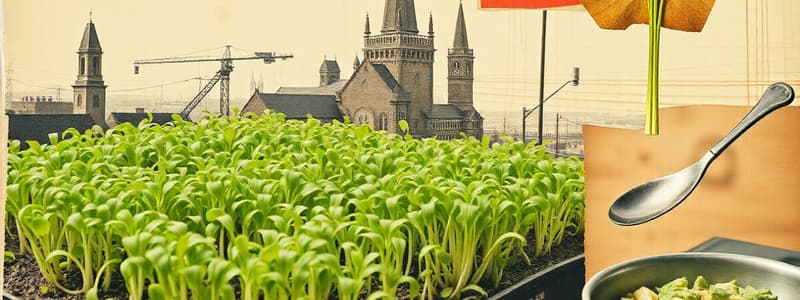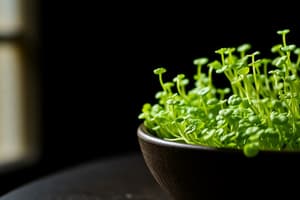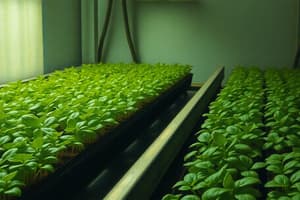Podcast
Questions and Answers
What are microgreens primarily harvested for?
What are microgreens primarily harvested for?
- Their mature seeds
- Their flowers
- Their young edible leaves (correct)
- Their roots
Which of the following is NOT a common type of microgreen?
Which of the following is NOT a common type of microgreen?
- Radish
- Pea shoots
- Arugula
- Kale (correct)
What is a key requirement for cultivating microgreens?
What is a key requirement for cultivating microgreens?
- Extreme temperatures
- Dry soil conditions
- Limited light
- Abundant moisture (correct)
How long after germination are microgreens typically harvested?
How long after germination are microgreens typically harvested?
Why are microgreens considered more nutrient-dense than their mature counterparts?
Why are microgreens considered more nutrient-dense than their mature counterparts?
Flashcards are hidden until you start studying
Study Notes
Microgreens
-
Definition:
- Microgreens are edible young plants harvested at an early stage of growth, typically when they have developed their first true leaves, known as cotyledons.
-
Common Types:
- Arugula
- Basil
- Beet greens
- Broccoli
- Radish
- Pea shoots
-
Cultivation:
- Grown in soil, coconut coir, or hydroponically.
- Require ample light, moisture, and appropriate temperature.
- Typically grown indoors, but can also flourish outdoors in favorable conditions.
- Harvested about 7-21 days after germination, depending on the species.
-
Nutritional Benefits:
- Rich in vitamins (E, C, K) and minerals (calcium, magnesium).
- High in antioxidants and phytochemicals.
- Often more nutrient-dense than their mature counterparts.
-
Culinary Uses:
- Used as garnishes for salads, soups, sandwiches, and various dishes.
- Adds flavor and texture; can be spicy (e.g., radish) or mild (e.g., basil).
-
Health Considerations:
- Proper sanitation is essential to avoid contamination.
- Vulnerable to pests and diseases; organic methods help improve resilience.
-
Economic Aspects:
- Popular in restaurants and amongst health enthusiasts.
- Can be cultivated in small spaces, making them suitable for urban farming.
-
Sustainability:
- Low resource requirement compared to traditional farming.
- Short growth cycle leads to efficient production.
-
Trends:
- Increasing interest in home gardening and hydroponics.
- Growing varieties and flavors being explored.
-
Storage:
- Best when consumed fresh.
- Can be stored in the refrigerator for a short period; ideal environment is slightly humid and cool.
Microgreens Definition
- Young edible plants harvested at an early stage of growth
- Typically harvested when the first true leaves (cotyledons) have developed
Microgreens Common Types
- Arugula, Basil, Beet greens, Broccoli, Radish, Pea shoots
Microgreens Cultivation
- Grown in soil, coconut coir, or hydroponically
- Require ample light, moisture, and appropriate temperatures
- Typically grown indoors, but can flourish outdoors in favorable conditions
- Harvested around 7-21 days after germination, depending on the species
Microgreens Nutritional Benefits
- Rich in vitamins (E, C, K) and minerals (calcium, magnesium)
- High in antioxidants and phytochemicals
- Often more nutrient-dense than mature counterparts
Microgreens Culinary Uses
- Used as garnishes for salads, soups, sandwiches, and various dishes
- Adds flavor and texture; can be spicy (e.g., radish) or mild (e.g., basil)
Microgreens Health Considerations
- Proper sanitation is essential to avoid contamination
- Vulnerable to pests and diseases; organic methods can improve resilience
Microgreens Economic Aspects
- Popular in restaurants and amongst health enthusiasts
- Can be cultivated in small spaces, making them suitable for urban farming
Microgreens Sustainability
- Low resource requirement compared to traditional farming
- Short growth cycle leads to efficient production
Microgreens Trends
- Increasing interest in home gardening and hydroponics
- Growing varieties and flavors being explored
Microgreens Storage
- Best when consumed fresh
- Can be stored in the refrigerator for a short period; ideal environment is slightly humid and cool
Studying That Suits You
Use AI to generate personalized quizzes and flashcards to suit your learning preferences.


